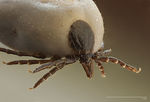Difference between revisions of "Hard Ticks - UK"
(Redirected page to Category:Hard Ticks - UK) |
|||
| (17 intermediate revisions by 2 users not shown) | |||
| Line 1: | Line 1: | ||
| − | + | [[Image:Ixodes ricinus.jpg|thumb|right|150px|''Ixodes ricinus'' - Richard Bartz, Wikimedia Commons]] | |
| + | ===Ixodes ricinus=== | ||
| + | This is a common hard tick found in the UK. As with most hard ticks ''Ixodes ricinus'' is a 3 host tick as well as a 3 stage life cycle. The ticks spend the mojority of their life on the ground, only requiring a blood meal prior to moulting to the next stage. The ''Ixodes ricinus'' life cycle normally takes 3 year but can range from 2 - 7 years in some cases, during this life cycle the tick will normally feed 3 times. After becoming adult the female will mate once whilst on the host before being shed to the ground. The female will lay several thousand eggs in matted vegetation such as rough pasture and hedgerows, following this she will die. | ||
| + | |||
| + | ===Ixodes canisuga=== | ||
| + | *Host specific dog tick | ||
| + | *Problem in kennels | ||
| + | |||
| + | ===Ixodes hexagonus=== | ||
| + | *Known as the hedgehog tick | ||
| + | *Affects hedgehogs, dogs, cats, ferrets and weasels | ||
| + | *Common in small animal practice | ||
| + | |||
| + | ===Haemaphysalis spp.=== | ||
| + | *Affects cattle | ||
| + | *Transmits ''Babesia major'', a relatively non-pathogenic protozoan parasite | ||
| + | *Uncommon | ||
| + | |||
| + | ===Dermacentor spp.=== | ||
| + | ''Dermacentor spp.'' can be identified by; | ||
| + | *Wide palps | ||
| + | *Rectangular base of capitulum | ||
| + | *Eyes | ||
| + | *Ornate | ||
| + | *Posterior anal groove | ||
| + | *Festoons on the posterior margin | ||
| + | There are two species found in the UK and europe ''D.reticulatus'', the caw tick, and ''D.marginatus'', the ornate sheep tick. ''D.reticulatus'' is a three host tick found on meadows, pastures and forests in England and Wales. Adults will parasitse large mammals whilst larval and nymphal stages attack small mammals, insectivores and sometimes birds. The tick is known to transmitt a number of disease in man and and veterinary species. ''D.reticulatus'' is responsible for transmitting ''Babesia canis'' in dogs, ''B.divergens'' and ''B.ovis''in cattle as well as Q fever (''C.burnetii''), tularemia, ''Brucella'', ''Anaplasma ovis'' and ''Rickettsia conorii'' the cause of Boutonneuse fever. In horse ''D.reticulatus'' is responsible for the transmission of ''Babesia caballi'' and ''B.equi''. | ||
| + | |||
| + | ===Rhipicephalus spp.=== | ||
| + | There are 2 Rhipicepphalus species found in Europe; ''R.sanguineus'',the brown dog tick and ''R.bursa'', which infect horses. | ||
| + | |||
| + | [[Category:Ticks]] | ||
| + | [[Category:To_Do_-_NickJ]] | ||
Revision as of 12:22, 8 July 2010
Ixodes ricinus
This is a common hard tick found in the UK. As with most hard ticks Ixodes ricinus is a 3 host tick as well as a 3 stage life cycle. The ticks spend the mojority of their life on the ground, only requiring a blood meal prior to moulting to the next stage. The Ixodes ricinus life cycle normally takes 3 year but can range from 2 - 7 years in some cases, during this life cycle the tick will normally feed 3 times. After becoming adult the female will mate once whilst on the host before being shed to the ground. The female will lay several thousand eggs in matted vegetation such as rough pasture and hedgerows, following this she will die.
Ixodes canisuga
- Host specific dog tick
- Problem in kennels
Ixodes hexagonus
- Known as the hedgehog tick
- Affects hedgehogs, dogs, cats, ferrets and weasels
- Common in small animal practice
Haemaphysalis spp.
- Affects cattle
- Transmits Babesia major, a relatively non-pathogenic protozoan parasite
- Uncommon
Dermacentor spp.
Dermacentor spp. can be identified by;
- Wide palps
- Rectangular base of capitulum
- Eyes
- Ornate
- Posterior anal groove
- Festoons on the posterior margin
There are two species found in the UK and europe D.reticulatus, the caw tick, and D.marginatus, the ornate sheep tick. D.reticulatus is a three host tick found on meadows, pastures and forests in England and Wales. Adults will parasitse large mammals whilst larval and nymphal stages attack small mammals, insectivores and sometimes birds. The tick is known to transmitt a number of disease in man and and veterinary species. D.reticulatus is responsible for transmitting Babesia canis in dogs, B.divergens and B.ovisin cattle as well as Q fever (C.burnetii), tularemia, Brucella, Anaplasma ovis and Rickettsia conorii the cause of Boutonneuse fever. In horse D.reticulatus is responsible for the transmission of Babesia caballi and B.equi.
Rhipicephalus spp.
There are 2 Rhipicepphalus species found in Europe; R.sanguineus,the brown dog tick and R.bursa, which infect horses.
